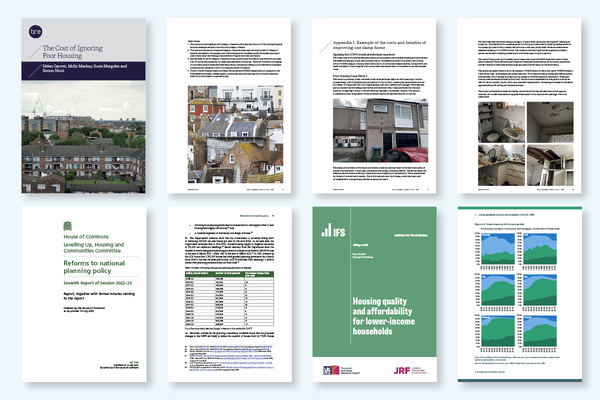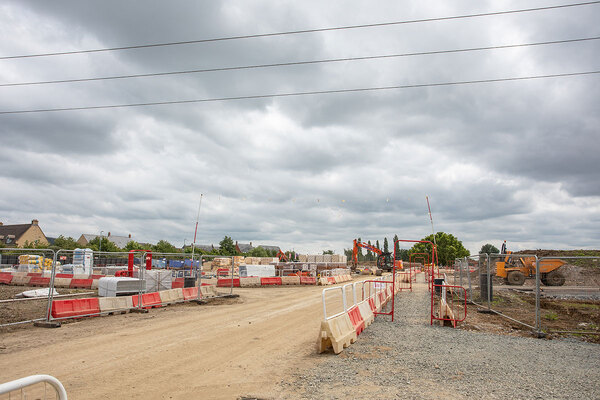The Thinkhouse Review: a period of stability is needed
Steve Moseley picks out the most interesting housing research from the past month, covering the impact of freezing the Local Housing Allowance, planning policy reform and the potential savings to the NHS of quickly investing to remove damp, mould and other health hazards from our homes
Either prompted by the rush to publish ahead of the summer break or the sheer number of different policy areas impacting housing which are worthy of comment at the moment, July was a bumper month for reports placed on the Thinkhouse website, with 11 new reports for scoring and analysis by the editorial panel.
For my review this month, I have picked out three which particularly grabbed my attention – noticeable in equal measure for their excellence and some of the depressing trends and stats they so eloquently convey.
The first of these is the Levelling Up, Housing and Communities Select Committee report into Reforms to national planning policy. The inquiry launched in February 2023 and involved two oral evidence sessions involving representative housing bodies, as well as sessions with housing minister Rachel Maclean and the Department for Levelling Up, Housing and Communities’ director general.
“It’s a report well worth reading, not just because of the weight attached to a report representing the views from a cross-party grouping of MPs, but also the significance of the many conclusions it draws which seem to reflect a degree of concern with current plans”
The inquiry is focused on the raft of different planning reforms announced since 2019, which it notes is in part connected to the revolving door of housing ministers – there have been five postholders since the start of 2022. The report and its conclusions are grouped into six key themes covering the proposed reforms and impact, including areas such as planning targets, resourcing and the proposed infrastructure levy.
It’s a report well worth reading, not just because of the weight attached to a report representing the views from a cross-party grouping of MPs, but also the significance of the many conclusions it draws which seem to reflect a degree of concern with current plans. Key among these is the recommendation that government “must see the merit in pausing plans for further reform, in order to allow for a period of stability in which reforms already introduced can be properly implemented”.
The report supports the principle of a plan-led system, but reiterates previous recommendations that the government should also set targets by tenure including, within that, a national housing target for 90,000 social rent homes per year.
It concludes by referencing the stop/start nature of planning reform over several years, which has caused uncertainty among local authorities and across the planning sector, and voices a concern that, if this is not addressed, the government will not achieve its national housing target of building 300,000 net new homes per year.
The second report I have picked out is The Cost of Ignoring Poor Housing by the Building Research Establishment (BRE). This builds on the BRE’s earlier cost of poor housing research and estimates the costs and benefits of tackling England’s poor housing over the next 30 years. It does this by utilising HM Treasury Green Book methodology, English Housing Survey (EHS) data and considering costs to the NHS, as well as wider societal costs and benefits.
By considering the EHS estimate of 2.4 million homes in England with at least one Category 1 health and safety hazard, it concludes it is costing the NHS more than £1bn per year to treat those people who are affected by poor housing.
“It would cost £250m to address the 65,000 affected homes, but undertaking this work immediately would create a benefit of £4.8bn over the next 30 years”
It goes on to estimate that the cost of remedial work to make the 2.4 million poor homes healthy and safe (removing all Category 1 hazards) is around £9bn and, if all this work were to be undertaken immediately, savings to the NHS would mean the investment would pay back in under nine years. On damp and mould specifically, something which is obviously such a significant and ongoing concern for residents and landlords, it estimates it would cost £250m to address the 65,000 affected homes, but undertaking this work immediately would create a benefit of £4.8bn over the next 30 years.
The report concludes by stating one of its key aims is to encourage discussion and further research, and hopes this model can be used to make the case for targeting resources on the most urgent situations and vulnerable households.
The final report – Housing quality and affordability for lower-income households – is from the Institute for Fiscal Studies (IFS). The IFS’s reputation as a politically neutral and truly independent organisation providing expert analysis of economic and social policy, is well earned. Like many people, I have watched enthralled as many a chancellor’s Budget has been carefully and painstakingly unpacked on national news.
This report breaks down the trends behind rising housing costs for lower-income households, which it sets out clearly in a series of salutary facts and fascinating but depressing charts. It details the trend of increasing numbers of low-income households residing in the private rented sector, driven by the scarcity of social housing.
“In the first quarter of 2023, just 5% of properties were affordable to low-income households – less than half the proportion affordable before the pandemic”
This matters, the IFS states, because those in the private rented sector have higher housing costs than both social renters and those owning with a mortgage, as well as having less security of tenure.
The main focus of the report is affordability and in doing that it focuses specifically on Local Housing Allowance rates (LHA). In 2011, LHA rates were cut to the 30th percentile of local rents. But from 2013-14, rather than maintaining the 30th percentile, LHA rates were uprated by the Consumer Price Index of inflation plus 1%, or frozen. In the wake of the pandemic, the government reset all LHA levels to the 30th percentile of September 2019 rents, which was frozen again in cash terms.
The consequence of this, the IFS states, is that in the first quarter of 2023, just 5% of properties were affordable to low-income households – less than half of the proportion affordable before the pandemic, and less than a quarter of the proportion affordable back in 2013. Those that are tend to be the least energy efficient, raising their true cost.
The IFS describes housing costs as a first-order issue for poverty. It does note that how much support the government provides private renters through the benefit system is, to a significant extent, a political question. However, given the increasing prevalence of low-income households in this sector and with levels of support based on rents in 2019, the IFS concludes – with its typical independent bluntness: “It is difficult to think of any justification for pursuing the policy.”
Steve Moseley, executive group director, governance and transformation at L&Q, and member, Thinkhouse editorial panel
Sign up for our asset management newsletter
Already have an account? Click here to manage your newsletters













